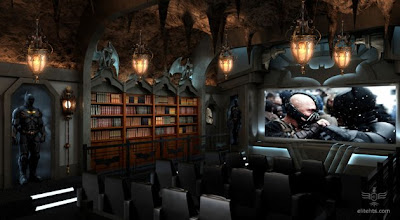A home theater is all about the giant-sized video screen and is usually set up in a “5.1” speaker format. The digit on the left side of the decimal tells us about the number of normal speakers that that particular system has. The numeric value on the right side, tells us about the number of subwoofers connected with it. Most of the people normally set up a home theater system in a room that is dedicated to provide the music listening, television watching, and extreme quality movie viewing experiences for the whole family. A conventional home theater room features a bombastic surround sound system, a 50 inch or bigger high-definition TV screen, and more than one rows of theater style comfortable seating.
In other words,
a home theater system can be defined as a dedicated space to watch movies, that
is equipped with a big video screen, (front screen projection or PLASMA flat
panels or Liquid Crystal Display), in combination with a multichannel, surround
sound system, and is the amalgam of two different types of media: audio and
video. The theater system seeks to reproduce a movie theater experience and
mood, with the help of its different video and audio components.
The Home Theater Speakers
The speakers of
a home theater system are normally placed at the height of the listener.
Surround sound speaker isn’t like a bookshelf speaker, it must not be kept
hidden. In fact, these speakers should be mounted on stands and placed just
behind the person that is watching television. Speaker shelves and brackets
must be fastened to at least one joist or stud. As far as ceiling and in-wall
speakers are concerned, they are secured with an essential mounting bracket
after cutting a hole in the ceiling or wall between the framing members. It
will be very unattractive to have a clutter of speakers that are hung on the
wall with their wires.
Home Theater Floors
The ways to
soundproof the floors are numerous. This completely depends on what the finish
is of the floor that is going to be installed. It would be way better for you
to use a soundproof floor underlay if you are planning to put pad and carpet on
the floor of your theater room. It is advised that you put carpet on the floors
of these rooms. Their floors must not be bare.
The Front Projector
Front projection
systems are for those rooms that are dedicated for the home theater systems.
Where you can regulate lighting, and which can be darkened even during daytime.
Front projection provides the most unspoiled picture. Projectors are generally placed
just below the ceiling across the room from the HDTV screen which makes the
quality of picture crystal clear.
A home theater
is really fun. It provides you a place to have lots of fun with the people you
should spend some time with. Where you can relax and entertain yourself. The
seating of that area must be very comfortable. After all, you want a place to
unwind, release your anxiety and make yourself comfortable!








